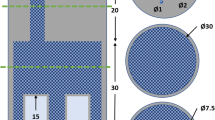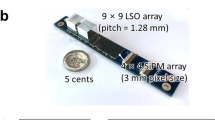Abstract
Purpose
PET radiotracers which incorporate longer-lived radionuclides enable biological processes to be studied over many hours, at centres remote from a cyclotron. This paper examines the radioisotope characteristics, imaging performance, radiation dosimetry and production modes of the four copper radioisotopes, 60Cu, 61Cu, 62Cu and 64Cu, to assess their merits for different PET imaging applications.
Methods
Spatial resolution, sensitivity, scatter fraction and noise-equivalent count rate (NEC) are predicted for 60Cu, 61Cu, 62Cu and 64Cu using a model incorporating radionuclide decay properties and scanner parameters for the GE Advance scanner. Dosimetry for 60Cu, 61Cu and 64Cu is performed using the MIRD model and published biodistribution data for copper(II) pyruvaldehyde bis(N4-methyl)thiosemicarbazone (Cu-PTSM).
Results
60Cu and 62Cu are characterised by shorter half-lives and higher sensitivity and NEC, making them more suitable for studying the faster kinetics of small molecules, such as Cu-PTSM. 61Cu and 64Cu have longer half-lives, enabling studies of the slower kinetics of cells and peptides and prolonged imaging to compensate for lower sensitivity, together with better spatial resolution, which partially compensates for loss of image contrast. 61Cu-PTSM and 64Cu-PTSM are associated with radiation doses similar to [18F]-fluorodeoxyglucose, whilst the doses for 60Cu-PTSM and 62Cu-PTSM are lower and more comparable with H215O.
Conclusion
The physical and radiochemical characteristics of the four copper isotopes make each more suited to some imaging tasks than others. The results presented here assist in selecting the preferred radioisotope for a given imaging application, and illustrate a strategy which can be extended to the majority of novel PET tracers.


Similar content being viewed by others
References
Blower PJ, Lewis JS, Zweit J. Copper radionuclides and radiopharmaceuticals in nuclear medicine. Nucl Med Biol 1996;23:957–80
Gambhir SS. Molecular imaging of cancer with positron emission tomography. Nat Rev Cancer 2002;2:684–93
Jayson GC, Zweit J, Jackson A, Mulatero C, Julyan P, Ranson M, et al. Molecular imaging and biological evaluation of HuMV833 anti-VEGF antibody: implications for trial design of antiangiogenic antibodies. J Natl Cancer Inst 2002;94:1484–93
Reader AJ, Zweit J. Developments in whole-body molecular imaging of live subjects. Trends Pharmacol Sci 2001;22:604–7
Gambhir SS, Herschman HR, Cherry SR, Barrio JR, Satyamurthy N, Toyokuni T, et al. Imaging transgene expression with radionuclide imaging technologies. Neoplasia 2000;2:118–38
Zweit J. Radionuclides and carrier molecules for therapy. Phys Med Biol 1996;41:1905–14
Smith SV. Molecular imaging with copper-64. J Inorg Biochem 2004;98:1874–901
Anderson CJ, Dehdashti F, Cutler PD, Schwarz SW, Laforest R, Bass LA, et al. 64Cu-TETA-octreotide as a PET imaging agent for patients with neuroendocrine tumours. J Nucl Med 2001;42:213–21
Adonai N, Nguyen KN, Walsh J, Iyer M, Toyokuni T, Phelps ME, et al. Ex vivo cell labeling with 64Cu-pyruvaldehydge-bis(N4-methylthiosemicarbazone) for imaging cell trafficking in mice with positron emission tomography. Proc Natl Acad Sci U S A 2002;99:3030–5
Dehdashti F, Grigsby PW, Mintun MA, Lewis JS, Siegel BA, Welch MJ. Assessing tumour hypoxia in cervical cancer by positron emission tomography with 60Cu-ATSM: relationship to therapeutic response—a preliminary report. Int J Radiat Oncol Biol Phys 2003;55:1233–8
Lewis MR, Wang M, Axworthy DB, Theodore LJ, Mallett RW, Fritzberg AR, et al. In vivo evaluation of pretargeted 64Cu for tumor imaging and therapy. J Nucl Med 2003;44:1284–92
Bischof Delaloye A, Delaloye B, Buchegger F, Vogel C-A, Gillet M, Mach J-P, et al. Comparison of copper-67-and iodine-125-labeled anti-CEA monoclonal antibody biodistribution in patients with colorectal tumours. J Nucl Med 1997;38:847–53
Grünberg J, Knogler K, Waibel R, Novak-Hofer I. High-yield production of recombinant antibody fragments in HEK-293 cells using sodium butyrate. Biotechniques 2003;34:968–72
Julyan PJ, Robinson S, Bailey J, Reader AJ, Marsland B, Kacperek A, et al. Performance of the GE advance PET scanner for non-pure positron emitters—prediction and validation using 124I. J Nucl Med 2001;42 suppl:205P
Robinson S, Julyan PJ, Hastings DL, Zweit J. Performance of a block detector PET scanner in imaging non-pure positron emitters—modelling and experimental validation with 124I. Phys Med Biol 2004;49:5505–28
DeGrado TR, Turkington TG, Williams JJ, Stearns CW, Hoffman JM, Coleman RE. Performance characteristics of a whole-body PET scanner. J Nucl Med 1994;35:1398–406
Karp JS, Daube-Witherspoon ME, Hoffman EJ, Lewellen TK, Links JM, Wong WH, et al. Performance standards in positron emission tomography. J Nucl Med 1991;12:2342–50
Green MA, Mathias CJ, Welch MJ, McGuire AH, Perry D, Fernandez-Rubio F, et al. Copper-62-labeled pyruvaldehyde bis(N4-methylthiosemicarbazonato)copper(II): synthesis and evaluation as a positron emission tomography tracer for cerebral and myocardial perfusion. J Nucl Med 1990;31:1989–96
King MM. Nuclear data sheets update for A=60. Nucl Data Sheets 1993;69:1–67
Bhat MR. Nuclear data sheets for A=61. Nucl Data Sheets 1999;88:417–532
Junde H, Singh B. Nuclear data sheets for A=62. Nucl Data Sheets 2000;91:317–422
Singh B. Nuclear data sheets for A=64. Nucl Data Sheets 1996;78:395–546
Tilley DR, Weller HR, Cheves CM, Chasteler RM. Energy levels of light nuclei A=18–19. Nucl Phys 1995;A595:1–170
Levin CS, Hoffman EJ. Calculation of positron range and its effect on the fundamental limit of positron emission tomography system spatial resolution. Phys Med Biol 1999;44:781–99
Derenzo SE, Hasigut RR, Fujiwara K. Precision Measurement of annihilation point spread distributions for medically important positron emitters. Positron annihilation. Sendai: The Japan Institute of Metals; 1979
Strother SC, Casey ME, Hoffman EJ. Measuring PET scanner sensitivity: relating countrates to image signal-to-noise ratios using noise equivalent counts. IEEE Trans Nucl Sci 1990;37:783–8
Wallhaus TR, Lacy J, Whang J, Green MA, Nickles RJ, Stone CK. Human biodistribution and dosimetry of the PET perfusion agent copper-62-PTSM. J Nucl Med 1998;39:1958–64
Lederer CM, Shirley VS. Tables of the isotopes. 7th ed. New York: Wiley; 1978
Loevinger R, Budinger TF, Warson EE. MIRD primer for absorbed dose calculations: revised edition. New York: Society of Nuclear Medicine; 1991
ICRP [International Commission on Radiation Protection]. ICRP 80: Radiation dose to patients from radiopharmaceuticals (Addendum 2 to ICRP 53). Ann ICRP 1998;28:1–126
Hays MT, Watson EE, Thomas SR, Stabin M. MIRD dose estimate report no. 19: Radiation absorbed dose estimates from 18F-FDG. J Nucl Med 2002;43:210–4
Martin CC, Oakes TR, Nickles RJ. Small cyclotron production of [Cu-60] for PET blood flow measurements. J Nucl Med 1990;31:815P
Szelecsényi F, Blessing G, Qaim SM. Excitation functions of proton induced nuclear reactions on enriched 61Ni and 64Ni: possibility of production of no-carrier-added 61Cu and 64Cu at a small cyclotron. Appl Radiat Isotopes 1993;44:575–80
Piel H, Qaim SM, Stöcklin G. Excitation functions of (p,xn)-reactions on natNi and highly enriched 62Ni: possibility of production of medically important radioisotope 62Cu at a small cyclotron. Radiochim Acta 1992;57:1–5
Obata A, Kasamatsu S, McCarthy DW, Welch MJ, Saji H, Yonekura Y, et al. Production of therapeutic quantities of 64Cu using a 12 MeV cyclotron. Nucl Med Biol 2003;30:535–9
Zweit J, Smith AM, Downey S, Sharma HL. Excitation functions for deuteron induced reactions in natural nickel: production of no-carrier-added 64Cu from enriched 64Ni targets for positron emission tomography. Appl Radiat Isotopes 1991;42:193–7
Smith SV, Waters DJ, Di Bartolo NM, Hocking R. Novel separation of ultra pure high specific activity Cu-64. J Label Compd Radiopharm 2003;46:S45
Zweit J, Goodall R, Cox M, Babich JW, Potter GA, Sharma HL, et al. Development of a high performance zinc-62/copper-62 radionuclide generator for positron emission tomography. Eur J Nucl Med 1992;19:418–25
Zinn KR, Chaudhuri TR, Cheng TP, Morris JS, Meyer WA Jr. Production of no-carrier-added 64Cu from zinc metal irradiated under boron shielding. Cancer 1994;73:774–8
Haynes NG, Lacy JL, Nayak N, Martin CS, Dai D, Mathias CJ, et al. Performance of a 62Zn/62Cu generator in clinical trials of PET perfusion agent 62Cu-PTSM. J Nucl Med 2000;41:309–14
Fujibayashi Y, Taniuchi H, Yonekura Y, Ohtani H, Konishi J, Yokoyama A. Copper-62-ATSM: a new hypoxia imaging agent with high membrane permeability and low redox potential. J Nucl Med 1997;38:1155–60
Anderson CJ, Pajeau TS, Edwards WB, Sherman EL, Rogers BE, Welch MJ. In vitro and in vivo evaluation of copper-64-octreotide conjugates. J Nucl Med 1995;36:2315–25
Anderson CJ, Connett JM, Schwarz SW, Rocque PA, Guo LW, Philpott GW, et al. Copper-64-labeled antibodies for PET imaging. J Nucl Med 1992;33:1685–91
Flower MA, Zweit J, Hall AD, Burke D, Davies MM, Dworkin MJ, et al. 62Cu-PTSM and PET used for the assessment of angiotensin II-induced blood flow changes in patients with colorectal liver metastases. Eur J Nucl Med 2001;28:99–103
Muellehner, G. Effect of resolution improvement on required count density in ECT imaging: a computer simulation. Phys Med Biol 1985;30:163–73
Ribeiro MJ, Almeida P, Strul D, Ferreira N, Loc’h C, Brulon V, et al. Comparison of fluorine-18 and bromine-76 imaging in positron emission tomography. Eur J Nucl Med 1999;26:758–66
Williams HA, Julyan PJ. What you see ain’t what you get: investigating concentration recovery in PET. Nucl Med Commun 2003;24:456
Reader AJ, Julyan PJ, Williams H, Hastings DL, Zweit J. EM algorithm system modeling by image-space techniques for PET reconstruction. IEEE Trans Nucl Sci 2003;50:1392–7
Okazawa H, Yonekura Y, Fujibayashi Y, Nishizawa S, Magata Y, Ishizu K, et al. Clinical application and quantitative evaluation of generator-produced copper-62-PTSM as a brain perfusion tracer for PET. J Nucl Med 1994;35:1910–5
Mathias CJ, Welch MJ, Raichle ME, Mintun MA, Lich LL, McGuire AH, et al. Evaluation of a potential generator-produced PET tracer for cerebral perfusion imaging: single-pass cerebral extraction measurements and imaging with radiolabeled Cu-PTSM. J Nucl Med 1990;31:351–9
Acknowledgements
The authors wish to thank Michael Stabin of Vanderbilt University (Nashville, USA) for 60Cu, 61Cu and 64Cu S-factors, and Jeff Lacy of Proportional Technologies Inc. (Houston, USA) for clarifying the organ residence times for 62Cu-PTSM.
The work detailed in this paper was carried out in compliance with current UK law.
Author information
Authors and Affiliations
Corresponding author
Rights and permissions
About this article
Cite this article
Williams, H.A., Robinson, S., Julyan, P. et al. A comparison of PET imaging characteristics of various copper radioisotopes. Eur J Nucl Med Mol Imaging 32, 1473–1480 (2005). https://doi.org/10.1007/s00259-005-1906-9
Received:
Accepted:
Published:
Issue Date:
DOI: https://doi.org/10.1007/s00259-005-1906-9




